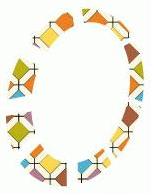A Matrix as template
We're all different. Species are different and within every specie every specimen is different. Some, are more different than others. But these difference are all assembled from the same construction materials and the same principles. Lets look at the construction materials first. One of these construction materials used are cells. We have different types of cells, in fact, all cells are different; but they have been assembled from the same kinds of molecules, biochemicals, and the same biochemical rules. One of the kinds of molecules are proteins. All proteins are different, but they have been assembled from the same building blocks, using the same type of programms. Proteins are build from amyno-acids and the programms are, of course, written in the language of neucleotic acid (DNA andRNA). So, although we're all different, we use the same elements, molecules, macro-molecules and scripting language.Secondly, we also adhere to the same principles. It doesn't matter if you belong to the genus of bacteria, plants, animals or men: we're all using the same principles for growth, development, evolution. Not only the same materials, but also the same rules. In fact, we even call bacteria growth in a petrie disk: 'a culture'. Just like what we call the folks that build Jericho, Thebe, Athens, Rome, Amsterdam or New York: a culture. We're all (and I mean all living beings) in the business of creating cultural value, capital, or, the word I like, worth. Bloom named 5 principles in his book 'Global Brain', which are also the 5 streams of the conference:
- Conformity enforcers, Politics, Analytic, Blue
- Inner judges, Science, Influential, Green,
- Diversity generators, Arts, Assertive, Yellow,
- Resource shifters, Commerce, Evaluative, Red,
- Cooperating and competing, Confrontation, Inventive, Azure,

Funny and not, Will McWhinney proposed 4 kinds of reality perceptions in his book 'Creating Paths of Change'. And the same archetypes can be found in Jung (symbols), the MBTI (personalities) and, as Tuft-Richardson discovered, in our four spiritualities. Hardjono found them in the dynamics of organisational change, again four. These principles are not only in our genes, not only in our myths, our tales, our thoughts, our memes, they're in our organizations and society. They're the manifestation of archetypes. Just like an architect designs, but doesn't build a house, the archetype designs but doesn't build our life. They're common knowledge, sometimes refered to as collective subconscious. And that is why I proposed to apply these rule in the design of the conference.
In this pilot Amsterdam Bloom Conference, the 5 principles of Global Brain, of social, learning networks have been applied again and again: they're in the overall structure of the two days, in the key-notes. They're in the five different streams of workshops and inside the workshop they'll be in the sub groups and inside the sub-group, there is you, the participant, bringing the principles too. And inside your head, in your brain, the same rules are applied, over and over again. Not only that, but the building, Felix Merites, has been designed as a meeting place for business, art, science and politicians. And Amsterdam, the big city built on poles, birth place of Spinoza, the god-father of Enlightment, is and has been a focal point for these principles.
In fact, the 5 streams can be looked at from two axes, making a matrix that looks like this:

>


0 Comments:
Post a Comment
<< Home